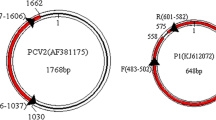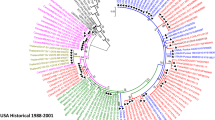Abstract
Blue-eye disease is an emergent viral swine infection caused by porcine rubulavirus (PoRV). We have developed a qRT-PCR method to detect and quantify expression of the nucleoprotein gene for different PoRV strains. The limit of detection for this assay was 102 copies of synthetic RNA. Viral RNA from PoRV was detectable at a TCID50 of 0.01. Significant differences were observed between viral RNA quantification and virus titration results for nine PoRV strains. For nasal and oral swab samples that were collected from experimentally infected pigs, the qRT-PCR assay was more sensitive (87.1–83.9 %) for the detection of positive samples than methods involving isolation of virus. The implementation of highly sensitive assays that yield results quickly will be of great assistance in the eradication of PoRV from Mexico. We also believe that the newly developed qRT-PCR assay will help reduce the spread of this viral infection to other countries.

Similar content being viewed by others
Abbreviations
- BED:
-
Blue-eye disease
- CENID-MA:
-
Centro Nacional de Investigacion Disciplinaria en Microbiologia Animal
- IIF:
-
Indirect immunofluorescence
- INIFAP:
-
Instituto Nacional de Investigaciones Forestales: Agricolas y Pecuarias
- LPMV:
-
La Piedad Michoacan virus
- PAC:
-
Producción Animal Cerdos
- PoRV:
-
Porcine rubulavirus
- TCID:
-
Tissue culture infectious dose
References
Allan GM, McNeilly F, Walker I, Linne T, Moreno-Lopez J, Hernandez P, Kennedy S, Carroll BP, Herron B, Foster JC, Adair B (1996) A sequential study of experimental porcine paramyxovirus (LPMV) infection of pigs: immunostaining of cryostat sections and virus isolation. J Vet Diagn Invest 8:405–413
Boddicker JD, Rota PA, Kreman T, Wangeman A, Lowe L, Hummel KB, Thompson R, Bellini WJ, Pentella M, Desjardin LE (2007) Real-time reverse transcription-PCR assay for detection of mumps virus RNA in clinical specimens. J Clin Microbiol 45:2902–2908
Borraz-Arguello MdT, Santos-Lopez G, Vallejo-Ruiz V, Herrera-Camacho I, Reyes-Leyva J (2008) Caracterizacion biologica de tres aislamientos naturales del Rubulavirus porcino (Mexico) [Biological characterization of three natural isolates of the porcine rubulavirus (Mexico)]. Rev Biol Trop 56:487–499
Boxus M, Letellier C, Kerkhofs P (2005) Real time RT-PCR for the detection and quantitation of bovine respiratory syncytial virus. J Virol Methods 125:125–130
Cuevas JS, Rodriguez-Ropon A, Kennedy S, Moreno-Lopez J, Berg M, Hernandez-Jauregui P (2009) Investigation of T-cell responses and viral mRNA persistence in lymph nodes of pigs infected with porcine rubulavirus. Vet Immunol Immunopathol 127:148–152
Escobar-Lopez AC, Rivera-Benitez JF, Castillo-Juarez H, Ramirez-Mendoza H, Trujillo-Ortega ME, Sanchez-Betancourt JI (2012) Identification of antigenic variants of the porcine rubulavirus in sera of field swine and their seroprevalence. Transbound Emerg Dis 59:416–420
Forcic D, Kosutic-Gulija T, Santak M, Jug R, Ivancic-Jelecki J, Markusic M, Mazuran R (2010) Comparisons of mumps virus potency estimates obtained by 50 % cell culture infective dose assay and plaque assay. Vaccine 28:1887–1892
Hernandez-Jauregui P, Ramirez Mendoza H, Mercado Garcia C, Moreno-Lopez J, Kennedy S (2004) Experimental porcine rubulavirus (La Piedad-Michoacan virus) infection in pregnant gilts. J Comp Pathol 130:1–6
Hjertner B, Wiman AC, Svenda M, Berg M, Moreno-Lopez J, Linne T (1998) Multiple factors including subgenomic RNAs and reduced viral protein expression are associated with a persistent infection by porcine rubulavirus (LPMV). Arch Virol 143:425–439
Hoffmann B, Beer M, Schelp C, Schirrmeier H, Depner K (2005)Validation of a realtime RT-PCR assay for sensitive and specific detection of classical swine fever. J Virol Methods 130:36–44
Huggett J, Dheda K, Bustin A (2006) Normalization. In: Dorak T (ed) PCR real-time. Taylor & Francis Group, New York, pp 83–91
Krause CH, Eastick K, Ogilvie MM (2006) Real-time PCR for mumps diagnosis on clinical specimens—comparison with results of conventional methods of virus detection and nested PCR. J Clin Virol 37:184–189
Lamb R, Collins P, Kolakofsky D, Melero J, Nagai Y, Oldstone M, Pringle C, Rima B (2005) Family paramyxoviridae. In: Fauquet C, Mayo M, Maniloff J (eds) Virus taxonomy: the classification and nomenclature of viruses. The eighth report of the international committee on taxonomy of viruses. Elsevier Academic Press, San Diego, pp 655–668
Moreno-Lopez J, Correa-Giron P, Martinez A, Ericsson A (1986) Characterization of a paramyxovirus isolated from the brain of a piglet in Mexico. Arch Virol 91:221–231
Morilla A, Gonzalez-Vega D, Estrada E, Diosdado F (2002) Seroepidemiology of blue eye disease. In: Morilla A, Yoon K, Zimmerman J (eds) Trends in emerging viral infections of swine. Iowa State University Press, Ames, pp 59–64
Ramirez-Mendoza H, Hernandez-Jauregui P, Reyes-Leyva J, Zenteno E, Moreno-Lopez J, Kennedy S (1997) Lesions in the reproductive tract of boars experimentally infected with porcine rubulavirus. J Comp Pathol 117:237–252
Reina J, Ballesteros F, Mari M, Munar M (2001) Evaluation of different continuous cell lines in the isolation of mumps virus by the shell vial method from clinical samples. J Clin Pathol 54:924–926
Reyes-Leyva JR, Santos G, Hernández J, Espinosa B, del Tránsito Borraz M, Ramírez H, Vallejo V, Zenteno E (2002) Mecanismos moleculares de la patogenia viral: estudios con el Rubulavirus porcino. In: Cea Bonilla A, Del Arenal Mena IP, Riveros-Rosas H, Vázquez-Contreras E (eds) Mensaje Bioquímico XXVI, Depto. Bioquímica, Fac. Medicina, Universidad Nacional Autónoma de México, Mexico D.F., pp 99–127
Rozen S, Skaletsky H (2000) Primer 3 on the WWW for general users and for biologist programmers. Methods Mol Biol 132:365–386
Sanchez-Betancourt JI, Santos-Lopez G, Alonso R, Doporto JM, Ramirez-Mendoza H, Mendoza S, Hernandez J, Reyes-Leyva J, Trujillo ME (2008) Molecular characterization of the hemagglutinin-neuraminidase gene of porcine rubulavirus isolates associated with neurological disorders in fattening and adult pigs. Res Vet Sci 85:359–367
Solis M, Ramirez-Mendoza H, Mercado C, Espinosa S, Vallejo V, Reyes-Leyva J, Hernandez J (2007) Semen alterations in porcine rubulavirus-infected boars are related to viral excretion and have implications for artificial insemination. Res Vet Sci 83:403–409
Stephano HA, Gay GM, Ramirez TC (1988) Encephalomyelitis, reproductive failure and corneal opacity (blue eye) in pigs, associated with a paramyxovirus infection. Vet Rec 122:6–10
Uchida K, Shinohara M, Shimada S, Segawa Y, Doi R, Gotoh A, Hondo R (2005) Rapid and sensitive detection of mumps virus RNA directly from clinical samples by real-time PCR. J Med Virol 75:470–474
Wiman AC, Hjertner B, Linne T, Herron B, Allan G, McNeilly F, Adair B, Moreno-Lopez J, Berg M (1998) Porcine rubulavirus LPMV RNA persists in the central nervous system of pigs after recovery from acute infection. J Neurovirol 4:545–552
Wiriyarat W, Lerdsamran H, Pooruk P, Webster RG, Louisirirotchanakul S, Ratanakorn P, Chaichoune K, Nateerom K, Puthavathana P (2010) Erythrocyte binding preference of 16 subtypes of low pathogenic avian influenza and 2009 pandemic influenza A (H1N1) viruses. Vet Microbiol 146:346–349
Acknowledgments
The authors wish to thank Maricela Montalvo-Corral, Monica Resendiz, and Gerardo Santos-López for their aid in the interpretation of our results. The present study was funded by the following projects: PAPIIT-IN224611, CONACYT AC-90024, and CONACYT SSA C02-126709. José F. Rivera-Benitez is the recipient of a grant from the Consejo Nacional de Ciencia y Tecnologia (CONACYT) (ID 207402).
Conflict of interest
The authors declare that they have no conflict of interest.
Author information
Authors and Affiliations
Corresponding author
Rights and permissions
About this article
Cite this article
Rivera-Benitez, J.F., García-Contreras, A.d.C., Reyes-Leyva, J. et al. Efficacy of quantitative RT-PCR for detection of the nucleoprotein gene from different porcine rubulavirus strains. Arch Virol 158, 1849–1856 (2013). https://doi.org/10.1007/s00705-013-1672-0
Received:
Accepted:
Published:
Issue Date:
DOI: https://doi.org/10.1007/s00705-013-1672-0




